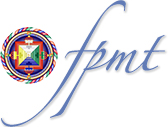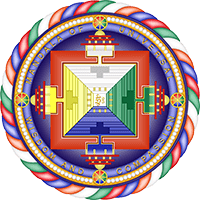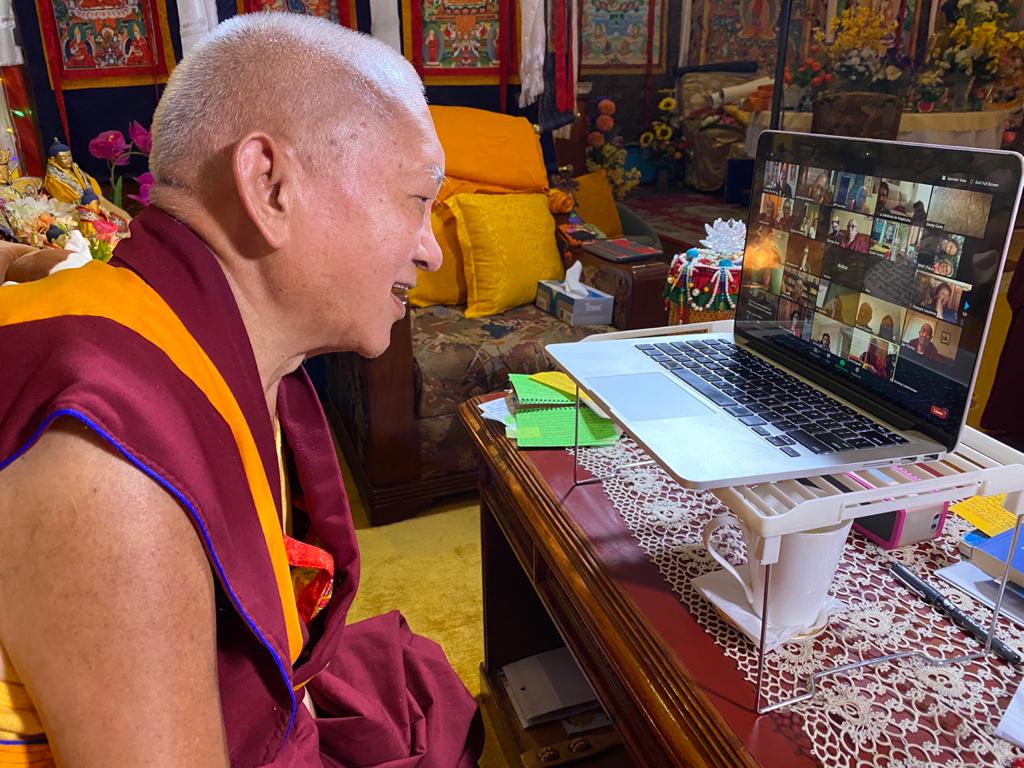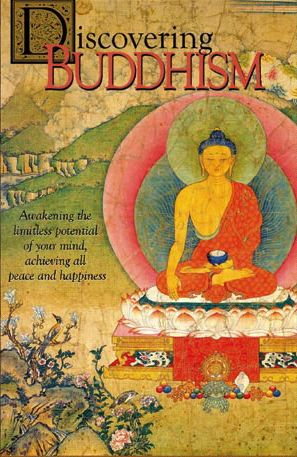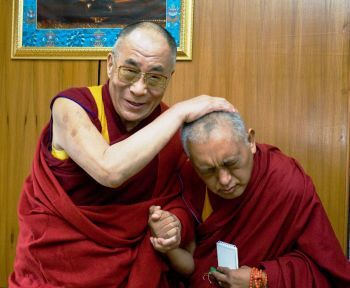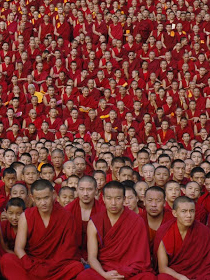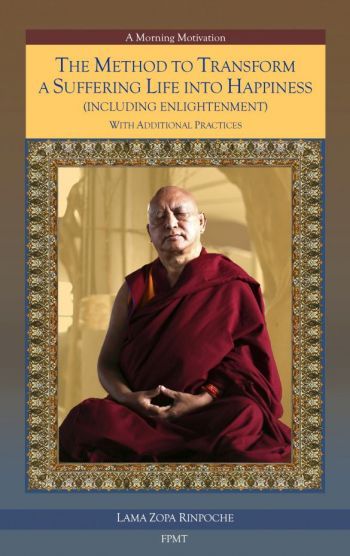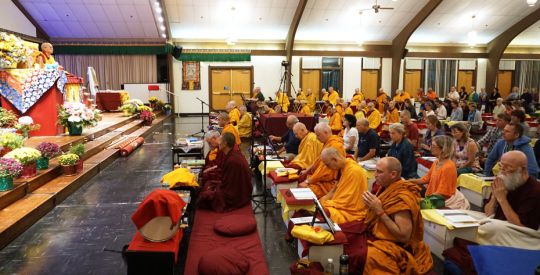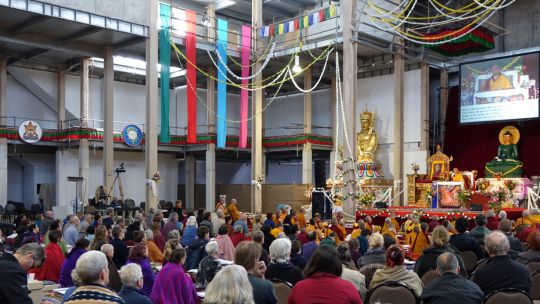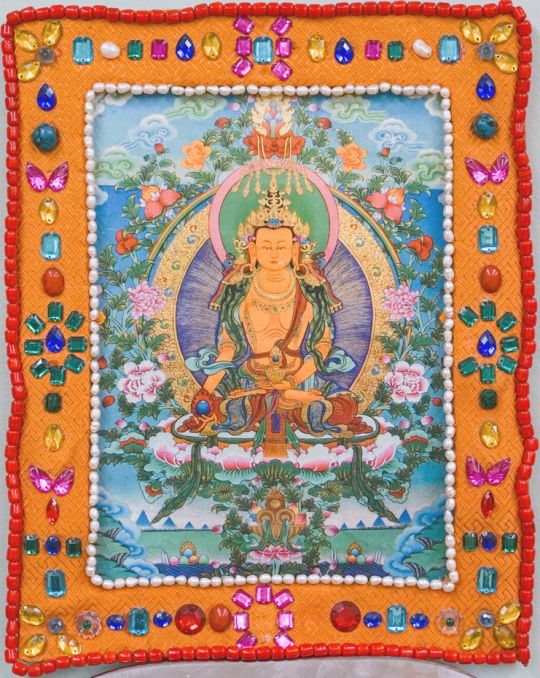- Home
- FPMT Homepage
Foundation for the Preservation of the Mahayana Tradition
The FPMT is an organization devoted to preserving and spreading Mahayana Buddhism worldwide by creating opportunities to listen, reflect, meditate, practice and actualize the unmistaken teachings of the Buddha and based on that experience spreading the Dharma to sentient beings. We provide integrated education through which people’s minds and hearts can be transformed into their highest potential for the benefit of others, inspired by an attitude of universal responsibility and service. We are committed to creating harmonious environments and helping all beings develop their full potential of infinite wisdom and compassion. Our organization is based on the Buddhist tradition of Lama Tsongkhapa of Tibet as taught to us by our founders Lama Thubten Yeshe and Lama Thubten Zopa Rinpoche.
- Willkommen
Die Stiftung zur Erhaltung der Mahayana Tradition (FPMT) ist eine Organisation, die sich weltweit für die Erhaltung und Verbreitung des Mahayana-Buddhismus einsetzt, indem sie Möglichkeiten schafft, den makellosen Lehren des Buddha zuzuhören, über sie zur reflektieren und zu meditieren und auf der Grundlage dieser Erfahrung das Dharma unter den Lebewesen zu verbreiten.
Wir bieten integrierte Schulungswege an, durch denen der Geist und das Herz der Menschen in ihr höchstes Potential verwandelt werden zum Wohl der anderen – inspiriert durch eine Haltung der universellen Verantwortung und dem Wunsch zu dienen. Wir haben uns verpflichtet, harmonische Umgebungen zu schaffen und allen Wesen zu helfen, ihr volles Potenzial unendlicher Weisheit und grenzenlosen Mitgefühls zu verwirklichen.
Unsere Organisation basiert auf der buddhistischen Tradition von Lama Tsongkhapa von Tibet, so wie sie uns von unseren Gründern Lama Thubten Yeshe und Lama Thubten Zopa Rinpoche gelehrt wird.
- Bienvenidos
La Fundación para la preservación de la tradición Mahayana (FPMT) es una organización que se dedica a preservar y difundir el budismo Mahayana en todo el mundo, creando oportunidades para escuchar, reflexionar, meditar, practicar y actualizar las enseñanzas inconfundibles de Buda y en base a esa experiencia difundir el Dharma a los seres.
Proporcionamos una educación integrada a través de la cual las mentes y los corazones de las personas se pueden transformar en su mayor potencial para el beneficio de los demás, inspirados por una actitud de responsabilidad y servicio universales. Estamos comprometidos a crear ambientes armoniosos y ayudar a todos los seres a desarrollar todo su potencial de infinita sabiduría y compasión.
Nuestra organización se basa en la tradición budista de Lama Tsongkhapa del Tíbet como nos lo enseñaron nuestros fundadores Lama Thubten Yeshe y Lama Zopa Rinpoche.
A continuación puede ver una lista de los centros y sus páginas web en su lengua preferida.
- Bienvenue
L’organisation de la FPMT a pour vocation la préservation et la diffusion du bouddhisme du mahayana dans le monde entier. Elle offre l’opportunité d’écouter, de réfléchir, de méditer, de pratiquer et de réaliser les enseignements excellents du Bouddha, pour ensuite transmettre le Dharma à tous les êtres. Nous proposons une formation intégrée grâce à laquelle le cœur et l’esprit de chacun peuvent accomplir leur potentiel le plus élevé pour le bien d’autrui, inspirés par le sens du service et une responsabilité universelle. Nous nous engageons à créer un environnement harmonieux et à aider tous les êtres à épanouir leur potentiel illimité de compassion et de sagesse. Notre organisation s’appuie sur la tradition guéloukpa de Lama Tsongkhapa du Tibet, telle qu’elle a été enseignée par nos fondateurs Lama Thoubtèn Yéshé et Lama Zopa Rinpoché.
Visitez le site de notre Editions Mahayana pour les traductions, conseils et nouvelles du Bureau international en français.
Voici une liste de centres et de leurs sites dans votre langue préférée
- Benvenuto
L’FPMT è un organizzazione il cui scopo è preservare e diffondere il Buddhismo Mahayana nel mondo, creando occasioni di ascolto, riflessione, meditazione e pratica dei perfetti insegnamenti del Buddha, al fine di attualizzare e diffondere il Dharma fra tutti gli esseri senzienti.
Offriamo un’educazione integrata, che può trasformare la mente e i cuori delle persone nel loro massimo potenziale, per il beneficio di tutti gli esseri, ispirati da un’attitudine di responsabilità universale e di servizio.
Il nostro obiettivo è quello di creare contesti armoniosi e aiutare tutti gli esseri a sviluppare in modo completo le proprie potenzialità di infinita saggezza e compassione.
La nostra organizzazione si basa sulla tradizione buddhista di Lama Tsongkhapa del Tibet, così come ci è stata insegnata dai nostri fondatori Lama Thubten Yeshe e Lama Zopa Rinpoche.
Di seguito potete trovare un elenco dei centri e dei loro siti nella lingua da voi prescelta.
- 欢迎 / 歡迎
简体中文
“护持大乘法脉基金会”( 英文简称:FPMT。全名:Foundation for the Preservation of the Mahayana Tradition) 是一个致力于护持和弘扬大乘佛法的国际佛教组织。我们提供听闻,思维,禅修,修行和实证佛陀无误教法的机会,以便让一切众生都能够享受佛法的指引和滋润。
我们全力创造和谐融洽的环境, 为人们提供解行并重的完整佛法教育,以便启发内在的环宇悲心及责任心,并开发内心所蕴藏的巨大潜能 — 无限的智慧与悲心 — 以便利益和服务一切有情。
FPMT的创办人是图腾耶喜喇嘛和喇嘛梭巴仁波切。我们所修习的是由两位上师所教导的,西藏喀巴大师的佛法传承。
繁體中文
護持大乘法脈基金會”( 英文簡稱:FPMT。全名:Found
ation for the Preservation of the Mahayana Tradition ) 是一個致力於護持和弘揚大乘佛法的國際佛教組織。我們提供聽聞, 思維,禪修,修行和實證佛陀無誤教法的機會,以便讓一切眾生都能 夠享受佛法的指引和滋潤。 我們全力創造和諧融洽的環境,
為人們提供解行並重的完整佛法教育,以便啟發內在的環宇悲心及責 任心,並開發內心所蘊藏的巨大潛能 — 無限的智慧與悲心 – – 以便利益和服務一切有情。 FPMT的創辦人是圖騰耶喜喇嘛和喇嘛梭巴仁波切。
我們所修習的是由兩位上師所教導的,西藏喀巴大師的佛法傳承。 察看道场信息:
- FPMT Homepage
- News/Media
-
- Study & Practice
-
-
- About FPMT Education Services
- Latest News
- Programs
- New to Buddhism?
- Buddhist Mind Science: Activating Your Potential
- Heart Advice for Death and Dying
- Discovering Buddhism
- Living in the Path
- Exploring Buddhism
- FPMT Basic Program
- FPMT Masters Program
- FPMT In-Depth Meditation Training
- Maitripa College
- Lotsawa Rinchen Zangpo Translator Program
- Universal Education for Compassion & Wisdom
- Online Learning Center
-
- Prayers & Practice Materials
- Overview of Prayers & Practices
- Full Catalogue of Prayers & Practice Materials
- Explore Popular Topics
- Benefiting Animals
- Chenrezig Resources
- Death & Dying Resources
- Lama Chopa (Guru Puja)
- Lama Zopa Rinpoche: Compendium of Precious Instructions
- Lama Zopa Rinpoche: Life Practice Advice
- Lama Zopa Rinpoche Practice Series
- Lamrim Resources
- Mantras
- Prayer Book Updates
- Purification Practices
- Sutras
- Thought Transformation (Lojong)
- Audio Materials
- Dharma Dates - Tibetan Calendar
- Translation Services
- Publishing Services
- Ways to Offer Support
- Prayers & Practice Materials
-
- Teachings and Advice
- Find Teachings and Advice
- Lama Zopa Rinpoche Advice Page
- Lama Zopa Rinpoche: Compendium of Precious Instructions
- Lama Zopa Rinpoche Video Teachings
- ༧སྐྱབས་རྗེ་བཟོད་པ་རིན་པོ་ཆེ་མཆོག་ནས་སྩལ་བའི་བཀའ་སློབ་བརྙན་འཕྲིན།
- Podcasts
- Lama Yeshe Wisdom Archive
- Buddhism FAQ
- Dharma for Young People
- Resources on Holy Objects
- Teachings and Advice
-
-
*If a menu item has a submenu clicking once will expand the menu clicking twice will open the page.
-
-
- Centers
-
- Teachers
-
- Projects
-
-
-
-
*If a menu item has a submenu clicking once will expand the menu clicking twice will open the page.
-
-
- FPMT
-
-
-
-
-
May there be no war, disease or natural disaster such as fire, flood, earthquake and so forth. May everybody realize bodhichitta, the good heart, enjoy peace and happiness and as quickly as possible realize the wisdom directly perceiving emptiness, cease all their defilements and achieve enlightenment.
Lama Zopa Rinpoche
-
-
-
- Shop
-
-
-
The Foundation Store is FPMT’s online shop and features a vast selection of Buddhist study and practice materials written or recommended by our lineage gurus. These items include homestudy programs, prayers and practices in PDF or eBook format, materials for children, and other resources to support practitioners.
Items displayed in the shop are made available for Dharma practice and educational purposes, and never for the purpose of profiting from their sale. Please read FPMT Foundation Store Policy Regarding Dharma Items for more information.
-
-
Lama Zopa Rinpoche News and Advice
11
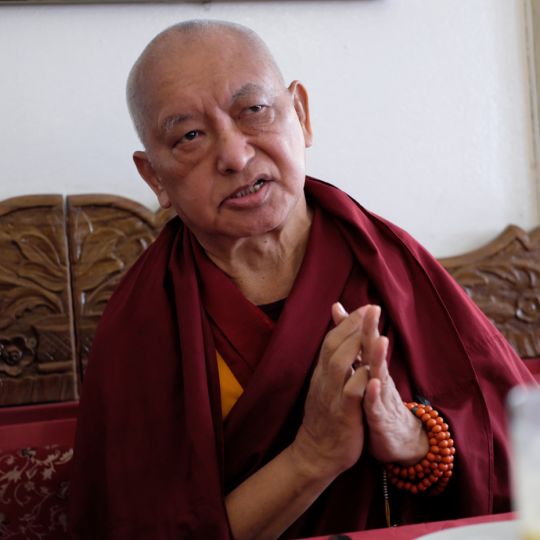
Lama Zopa Rinpoche at an Indian restaurant in Vienna, Austria, September 2017. Photo by Markus Igel.
Lama Zopa Rinpoche gave advice to a student who wrote to him about experiencing many obstacles and low self-esteem. Here’s an excerpt from Rinpoche’s advice, given in February 2017:
Regarding your question about low self-esteem, many people have low self-esteem, but it is by not thinking about karma and thinking only about worldly things, so low self-esteem is really a wrong label. It is not thinking about and understanding karma, so it’s like a wrong label. It’s a worldly mind. You think you don’t have what the country or society expects, but in reality the most important thing is Dharma. By understanding karma, you can see this. So I think low self-esteem is a wrong label; it is a more worldly way of thinking. …
The most important thing is to help any being with our body, speech, and mind, to help others, even insects, to help anybody who has any problem, to help in whatever way we can. I was saying in the teachings at Root Institute [in January 2017] that to share even an Indian rupee, even an anna [a small currency unit, worth less that a rupee] even if we only have that, we can make charity and share with those in need. In our daily life every single thing, whatever we can do to help others with our body, speech, and mind, it is very important in everyday life to help others as much as possible. In that way we create merit, unbelievable, unbelievable merit, especially if it is done with bodhichitta. That is very, very important.
Then making offering—for example, when we eat and drink—making offering to the guru, Buddha, Dharma, Sangha. By making offering to the guru it is the highest merit and the greatest purification and therefore the quickest way to enlightenment. [This includes] anything done toward the guru, such as obtaining advice, fulfilling the guru’s holy wishes and these things. Offering to the guru, Buddha, Dharma, Sangha—these are very powerful [objects] to create good karma, and most powerful is the guru. It says this in teachings of sutra and tantra; I’m not just making it up.
Also, taking care of our parents, not with attachment, but by thinking of them as sentient beings. So this life’s kind mother and kind father who took care of us, every single service [for them] is very powerful, good karma. We start to experience the result, happiness, in this life and then for many hundreds of thousands of lives, on and on, for lifetimes.
Read the complete advice “Low Self-Esteem,” posted in August 2017 by Lama Yeshe Wisdom Archive on “Lama Zopa Rinpoche’s Online Advice Book”:
https://www.lamayeshe.com/advice/low-self-esteem-0
The 100 Million Mani Retreat at Istituto Lama Tzong Khapa in Italy began on October 4! You can watch Lama Zopa Rinpoche teach live on YouTube and Facebook. For links and details:
https://fpmt.org/media/streaming/lama-zopa-rinpoche-live/
More information, photos and updates about FPMT spiritual director Lama Zopa Rinpoche can be found on Rinpoche’s webpage on FPMT.org. If you’d like to receive news of Lama Zopa Rinpoche and FPMT via email, sign up to FPMT News.
- Tagged: lama zopa rinpoche, negative emotions
9
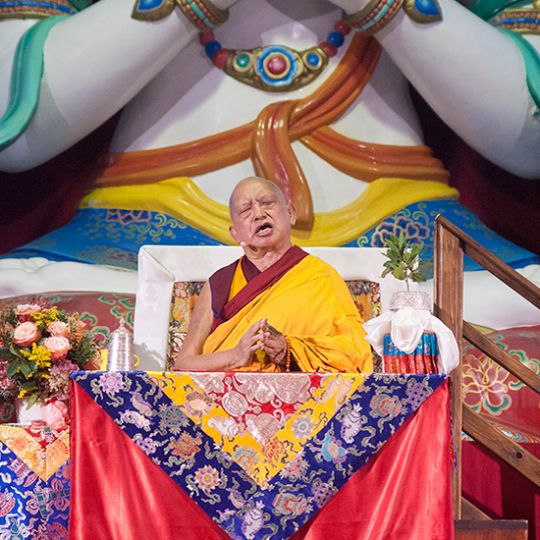
Lama Zopa Rinpoche teaching on the throne at 100 Million Mani Mantra Retreat, ILTK, Italy, October 2017. Photo by Piero Sirianni.
Istituto Lama Tzong Khapa (ILTK) in Italy is hosting the month-long 100 Million Mani Mantra Retreat with Lama Zopa Rinpoche that began last week. ILTK shared highlights of the first night’s teaching:
“We gather here to do the best thing in the life, to do the best thing in the the world, the best things in the life. And what we’re doing is the answer to all the problems in the world. The body, speech, and mind in the meditation of Chenrezig, the Compassion Buddha, is amazing, the most amazing thing.” With these words Lama Zopa Rinpoche began teaching at the 100 Million Mani Mantra Retreat at Istituto Lama Tzong Khapa.
Rinpoche talked about how we have to realize how fortunate we are that we’ve met with Mahayana Buddhism and that we shouldn’t take for granted our perfect human rebirth and meeting Mayahana Buddhism and great teachers like His Holiness the Dalai Lama. Rinpoche continued that with so many problems in the world—political, environmental and so forth—we are all desperately looking for a solution. “But the solution is inside our mind,” Rinpoche said.
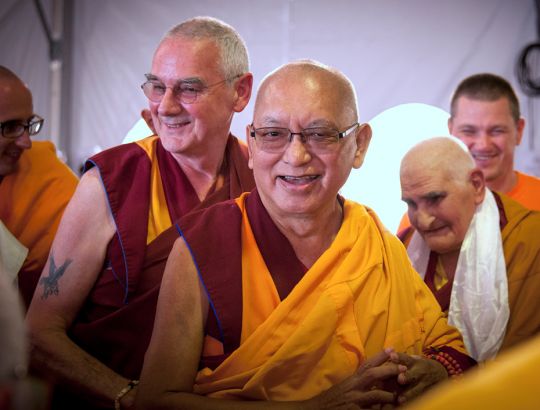
Lama Zopa Rinpoche, with Ven. Roger Kunsang, entering the teaching venue at the 100 Million Mani Retreat, ILTK, Italy, October 2017. Photo by Piero Sirianni.
He encouraged students to remember that reciting OM MANI PADME HUM is for all sentient beings and that not one being is left out, no matter now tiny. Reciting OM MANI PADME HUM one time with bodhichitta is fantastic, Rinpoche said.
“So it is incredible what we are doing here, that is answer for everything, answer for the world and answer for all your problems, to be free from samsara. … And not only that, to achieve buddhahood, the total cessation of obscurations and completion of all the realizations.”
Rinpoche offered the observation that we get so busy with studying, but then, when something happens, we are not prepared. Without correctly practicing, Rinpoche warned, we may be worse than someone who has never met the Dharma.
Later in the teaching Rinpoche said that we should take inspiration from Geshe Chekawa, who was happy when his body was suffering, because he was destroying his self-cherishing. Rinpoche told the retreatants that it is our choice and that problems do not exist from their own side, so that the same experience can be for us happiness or suffering. He encouraged us to cherish the one who abuses us, they are so precious and will lead us to enlightenment.
Watch the first teaching by Lama Zopa Rinpoche at the 100 Million Mani Mantra Retreat
Lama Zopa Rinpoche’s daily teachings at the 100 Million Mani Mantra Retreat in Italy are being broadcast live over Facebook and YouTube:
https://fpmt.org/media/streaming/lama-zopa-rinpoche-live/
You can watch recordings of previous teachings by Lama Zopa Rinpoche online:
https://fpmt.org/RinpocheNow/
Read advice from Lama Zopa Rinpoche about the benefits of Chenrezig Practice:
https://fpmt.org/education/prayers-and-practice-materials/chenrezig-mantra-and-practice/
More information, photos and updates about FPMT spiritual director Lama Zopa Rinpoche can be found on Rinpoche’s webpage on FPMT.org. If you’d like to receive news of Lama Zopa Rinpoche and FPMT via email, sign up to FPMT News.
4
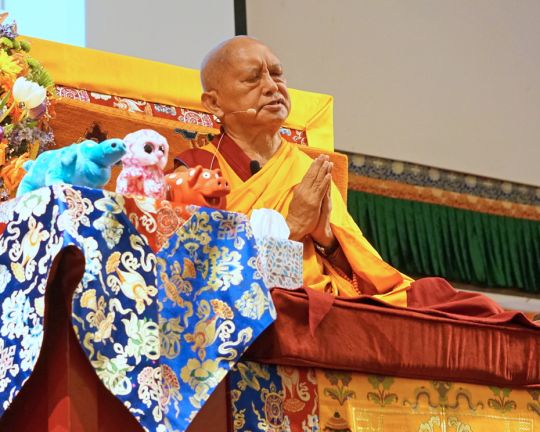
Lama Zopa Rinpoche at the Light of the Path retreat, North Carolina, US, September 2017. Photo by Ven. Lobsang Sherab.
On September 15, a long life puja was offered to Lama Zopa Rinpoche at the conclusion of the Light of the Path 2017 retreat, which was organized by Kadampa Center in North Carolina, US. During the puja, Merry Colony, a long-time student and current director of Milarepa Center, offered the following praise to Lama Zopa Rinpoche.
To Kyabje Lama Zopa Rinpoche,
From the vast sky of dharmakaya space, like a star appearing in the light of day, the most rare of fortunate events ripened when in the Himalayan village of Thame, Nepal, you appeared in this human form. Before you could even walk, you showed all the signs of being the unmistaken incarnation of the great Lawudo Lama meditator, Kunzang Yeshe. What a great auspiciousness!
As a child you thought to go to Mindroling Monastery in Tibet, but instead your uncle Ngawang Gendun brought you to the monastery of Domo Geshe Rinpoche. Thus, you ended up in Buxa after fleeing Tibet. While in Buxa, the monk Chumbi brought you to the room of Lama Thubten Yeshe and a karmic bond that would come to shine a great light on the dark land of the West was rekindled. What a great auspiciousness!
When Zina [Rachevsky] first requested Lama to teach in Bodhgaya, it was you, Supreme One, who accepted the request. Inspired by Kachen Yeshe Gyaltsen, you taught the first five-day course, which quickly grew to become a biannual event at Kopan. Now, forty-five years later, you have given the keys to liberation and enlightenment to tens of thousands of students at Kopan alone. What a great auspiciousness!
When the world turned dark on Losar morning in 1984 and Lama Yeshe passed away, you immediately took the helm of the FPMT organization and then traveled without break for so many years, steering the fledgling group of forty centers to its current status of more than 160 centers, projects, and services. Impeccably following the advice of His Holiness, you protected the centers and students from danger, becoming the mother, father, and protector of us all. What a great auspiciousness!
As the organization grew, you invited the most highly educated of Sera geshes to teach so that students everywhere could learn the great philosophical texts, while always ensuring that practice and the heart of service remained at the core. Like this, you initiated FPMT’s Basic Program and grew the Masters Program, paving the way for a new generation of well-educated and well-integrated teachers to serve the organization. What a great auspiciousness!
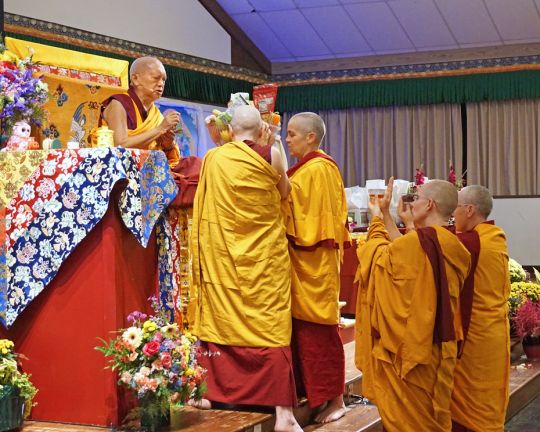
Lama Zopa Rinpoche during a tsog puja at the Light of the Path retreat, North Carolina, US, September 2017. Photo by Ven. Lobsang Sherab.
To help secure the longevity of the Sera monastic education, you established the Sera Je Food Fund, enabling the monks to focus on their studies and your students to create vast skies of merit. Likewise, you have overseen the continuous growth of Kopan Monastery and Khachoe Ghakyil Nunnery and have rebuilt monasteries vulnerable to degeneration in Mongolia, and in Tsum and Jailsa in Nepal, which are now flourishing. What a great auspiciousness!
Your vast vision to bring holy objects to every corner of the world is without equal. Exceeding the wishes of Lama Yeshe, two great statues of Maitreya Buddha will now be built in India, while great prayer wheels, stupas, Guru Rinpoche statues, giant thangkas, and other holy objects are going up around the world. Due to Rinpoche’s limitless compassion, even the animals and those without faith can now create merit, helping to bring peace to the world and balance to the elements. What a great auspiciousness!
Due to Rinpoche’s vision of benefiting sentient beings as vast as space, the Sanghata Sutra, the Sutra of Golden Light, the Vajra Cutter Sutra, and others are now recited regularly throughout the whole world; many thousands of nyung nä retreats have been completed; and many 100 million mani retreats and so many individual lamrim and deity retreats have been done. And due to Rinpoche’s indescribable kindness and guidance, we now have everything we need to help ourselves and others at the critical time of death. What a great auspiciousness!
Your help for children, the poor, the sick, and the elderly manifests in an ever-expanding circle of schools, homes for the destitute, clinics, and an eye hospital in Tibet. For so many animals bound for slaughter, you have created safe havens. Most recently, due to your great concern for the elderly who have been left alone in your homeland, an old-age Dharma home will be built where Sherpas destitute of help can live out their lives with Dharma and in peace. What a great auspiciousness!
But greatest of all your holy deeds are the unmatched, unexcelled, and unending treasury of Dharma teachings that Rinpoche gives every moment, with every breath, and with every movement of your holy body, speech, and mind. Having crisscrossed the globe continuously for more than forty-five years, you have given teachings like no other on the heart of the path—how to correctly devote to the virtuous friend—so that we may receive the nectar blessings needed to actualize the path. You have shown us how to carry out all our practices in the most extensive way to create the most extensive merit of virtue and merit of wisdom. You have shown us how to meditate precisely on the subtle points of emptiness so that we may cut the root of our ignorance. And by your peerless faultless example, you have shown us perfectly how to take the essence from every moment of our unfathomably perfect rebirths and make our lives most beneficial for others. What an indescribable auspiciousness!
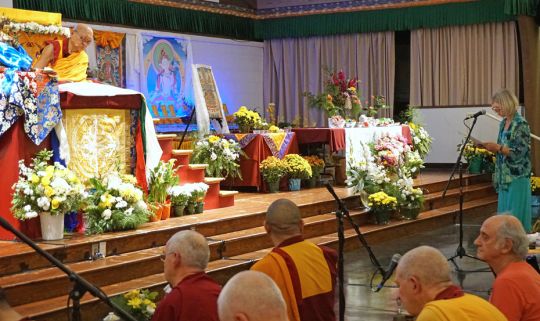
Merry Colony offering praise to Lama Zopa Rinpoche during the long life puja at the Light of the Path retreat, North Carolina, US, September 2017. Photo by Ven. Lobsang Sherab.
And yet, despite Rinpoche’s atomic energy and passion to blast us out of samsara, we are still children often lost and confused, in need of your continual guidance and care. Guru Chenrezig, Vajradhara, hear the prayers of your disciple children. You are our sole refuge protector and savior, our light of the path. Don’t ever leave us. Until we attain your enlightened state, hold us in your compassion and guide us.
Having shown us how to open the door of Dharma, we will work diligently to give up the meaningless affairs of this life. Having opened our hearts, we will work continuously to benefit living beings. Having opened our wisdom eye, we will persevere in our analysis of how things exist. Having saved our lives, we will dedicate ourselves to becoming most quickly like you so that our every action will be suffused with bodhichitta, our every breath most meaningful for others. May our pure practice be the cause for you to stay with us forever.
Guru Chenrezig, Vajradhara, hear the prayers of your disciple children. You are our sole refuge protector and savior, our light of the path. Don’t ever leave us. Until we attain your enlightened state, hold us in your compassion and guide us. May all auspiciousness continue to ripen.
Written and read by the devoted disciple Merry Colony at the conclusion of the Light of the Path retreat in Black Mountain, North Carolina, September 15, 2017.
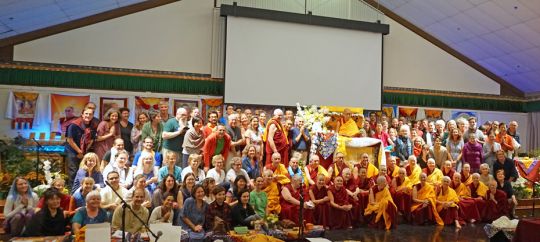
Participants of the Light of the Path retreat, North Carolina, US, September 2017. Photo by Ven. Losbang Sherab.
Lama Zopa Rinpoche is the spiritual director of the Foundation for the Preservation of Mahayana Tradition (FPMT), a Tibetan Buddhist organization dedicated to the transmission of the Mahayana Buddhist tradition and values worldwide through teaching, meditation, and community service.
The 100 Million Mani Retreat at Istituto Lama Tzong Khapa in Italy begins on October 4! You can watch Lama Zopa Rinpoche teach live on YouTube and Facebook. For links and details:
https://fpmt.org/media/streaming/lama-zopa-rinpoche-live/
- Tagged: lama zopa rinpoche, light of the path, light of the path 2017, long life puja, merry colony, praise for lama zopa rinpoche
2
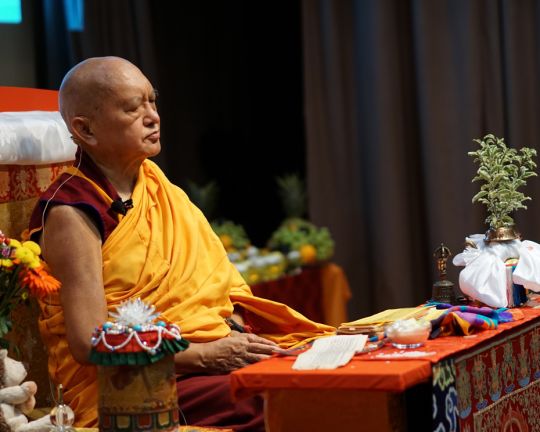
Lama Zopa Rinpoche giving a Medicine Buddha initiation in Vienna, Austria, September 2017. Photo by Ven. Lobsang Sherab.
In the Medicine Buddha sadhana published by FPMT Education Services, Lama Zopa Rinpoche offers advice on doing Medicine Buddha practice. Mantra recitation as part of the practice is very powerful, as Rinpoche explains:
The Medicine Buddha encompasses all the buddhas. This means that when we practice the seven-limb prayer and make offerings with the seven limbs, we receive the same merit as we would if we had made offerings to all the buddhas. Similarly, when we recite the mantra of Medicine Buddha, we collect unbelievable merit just as when we offer the seven-limb practice to Medicine Buddha.
To recite the Medicine Buddha mantra brings inconceivable merit. Manjushri requested the eight tathagatas (Guru Shakyamuni Buddha and the seven Medicine Buddhas) to reveal a special mantra that would make the prayers they (the eight tathagatas) made in the past (prayers to be able to actualize the happiness of sentient beings by attaining the path to enlightenment and pacifying various problems, to be able to see all the buddhas, and for all wishes to be quickly realized) to quickly come to pass, especially for those sentient beings born in the time of the five degenerations who have small merit and who are possessed and overwhelmed by various diseases and spirit harms.
During that time, all the eight tathagatas, in one voice, taught the Medicine Buddha mantra. Therefore, if you recite the mantra every day, the buddhas and bodhisattvas will always pay attention to you, and they will guide you. Vajrapani, owner of the secrets, and the four guardians will always protect and guide you. All your negative karmas will be pacified, and you will never be born in the three lower realms. Even just hearing a recitation of the names of the eight tathagatas pacifies all diseases and spirit harms—even spirit harms that arise as a condition of disease—and all your wishes are fulfilled.
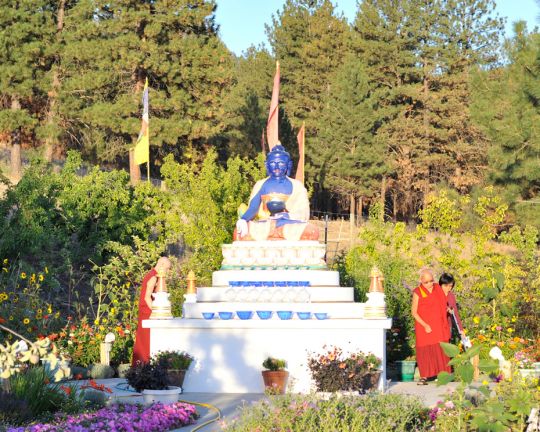
Lama Zopa Rinpoche circumambulates the Medicine Buddha statue at Buddha Amitabha Pure Land, Washington, US, August 2016. Photo by Ven. Lobsang Sherab.
This is just a brief explanation of the benefits of the Medicine Buddha practice. This practice is especially beneficial if you are helping others, especially if you are doing healing work. It helps you to be more accurate and beneficial. You will receive much support, not only from the eight tathagatas, but from the four clairvoyant devas as well. These devas can help you to diagnose and understand the right method to heal, as they are associated with the eight tathagatas.
Excerpted from Medicine Buddha Sadhana by Ngawang Losang Tenpa Gyältsän, translated by Lama Thubten Zopa Rinpoche, and prepared by Ven. Thubten Gyatso. Published by FPMT Education Services. Students can find the practice and mantra in this sadhana:
https://fpmt.org/wp-content/uploads/education/prayers/medicine_buddha_sadhana_c5.pdf
More prayers and practices can be found on FPMT.org:
https://fpmt.org/education/prayers-and-practice-materials/
FPMT.org and Mandala Publications brings you news of Lama Zopa Rinpoche and of activities, teachings, and events from over 160 FPMT centers, projects, and services around the globe. If you like what you read, consider becoming a Friend of FPMT, which supports our work.
- Tagged: lama zopa rinpoche, medicine buddha
27
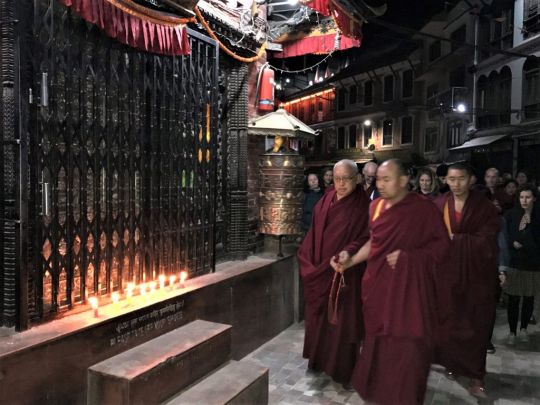
Lama Zopa Rinpoche, accompanied by attendants and students, circumambulates Boudhanath Stupa. Nepal, March 2017. Photo by Bill Kane.
Lama Zopa Rinpoche has stressed the importance of circumambulating holy objects like stupas and has given specific advice for how to do that. In March 2017, when he led a large group of students in a late-night circumambulation of the great stupa at Boudhanath in Nepal those present were referred to a short printout based on advice from Rinpoche that appears on Lama Yeshe Wisdom Archive’s website.
In brief, Rinpoche recommends the following steps:
FIRST, generate a strong motivation of bodhichitta.
SECOND, think that you have manifested numberless bodies yourself and that you are leading all sentient beings in the circumambulation.
THIRD, recite the special mantras and Buddha’s names:
CHOM DÄN DÄ DE ZHIN SHEG PA DRA CHOM PA YANG DAG PAR DZOG PÄI SANG GYÄ PÄL GYÄL WA SHAKYA THUB PA LA CHHAG TSHÄL LO
OM NAMO DASHA DEKA TRI KALA SARVA RATNA TRAYAYA MAMA PRADAKSHA SU PRA DAKSHA SARVA PAPAM BISHODHANI SVAHA (7X)
Reciting the second Buddha’s name and mantra increases the power of circumambulation or prostration ten million times:
CHOM DÄN DÄ DE ZHIN SHEG PA DRA CHOM PA YANG DAG PAR DZOG PÄI SANG GYÄ RIN CHHEN GYÄL TSHÄN LA CHHAG TSHÄL LO (7X)
[NAMO RATNA TRAYAYA] OM NAMO BHAGAVATE RATNA KETU RAJAYA TATHAGATAYA ARHATE SAMYAK SAMBUDDHAYA TADYATHA OM RATNE RATNE MAHA RATNE RATNA BIJA YE SVAHA (7X)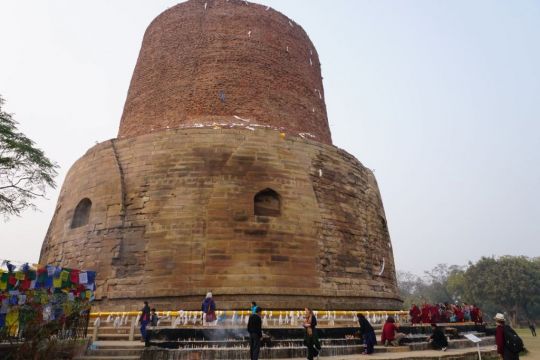
Lama Zopa Rinpoche, along with Sangha and other students, circumambulates the Dhamek stupa in Sarnath, India. January 2017. Photo by Ven. Lobsang Sherab.
FOURTH, visualize and always keep in mind that all the holy objects you are circumambulating (and all other holy objects) are manifestations of your root guru.
FIFTH, as you walk, recite mantras and prayers or texts you have memorized such as OM MANI PADME HUM, Vajrasattva mantra, Mitukpa mantra, the names of the Thirty-five Buddhas, Vajra Cutter Sutra, Praises to Buddha (Shakyamuni Buddha, Praise by Way of the Twelve Deeds) and Buddha’s mantra, Praises to the Twenty-one Taras and Tara’s mantra, Chanting the Names of Manjushri, Lama Tsongkhapa’s Guru Yoga prayer (migtsema) or In Praise of Dependent Origination (Dependent Arising: A Praise of the Buddha from The Splendor Of An Autumn Moon), the prayer for refuge and bodhichitta, the five powerful mantras* and so on. If you haven’t memorized these, you can read the texts as you go around.
SIXTH, as you do each circumambulation, dedicate it and give away the merit.
SEVENTH, rejoice in this unbelievable practice! Now dedicate the merit by reciting the dedication prayers, long life prayers, and mantras to increase the merit. Dedicate well and extensively in order to generate bodhichitta. Give away all the merits to all sentient beings and think they have achieved enlightenment.
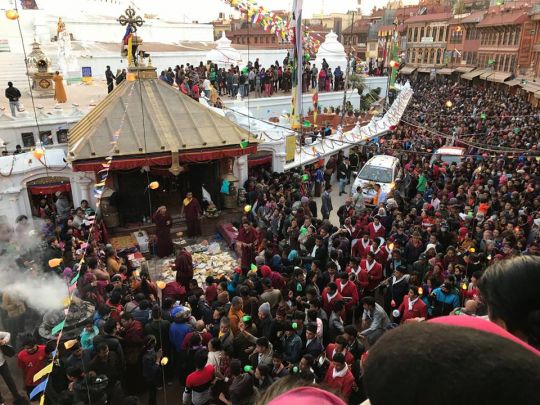
Crowds circumambulate Boudhanath Stupa on Chokor Duchen (the Day of Miracles). Nepal, March 2017. Photo by Bill Kane.
* The five powerful mantras are Kunrig (Vairochana); Mitukpa (Akshobya); Namgyalma (Ushnishavijaya); Stainless Pinnacle (Ushnishavimala); and Wish-Granting Wheel.
This advice from Lama Zopa Rinpoche on circumambulation appears in greater detail on Lama Yeshe Wisdom Archive’s website:
https://www.lamayeshe.com/article/kyabje-zopa-rinpoches-advice-circumambulation
To learn more about practices related to stupas, visit Stupas: A Resource Guide:
https://fpmt.org/education/practice/holy-objects/stupas-resources/
Lama Zopa Rinpoche is the spiritual director of the Foundation for the Preservation of Mahayana Tradition (FPMT), a Tibetan Buddhist organization dedicated to the transmission of the Mahayana Buddhist tradition and values worldwide through teaching, meditation and community service.
25
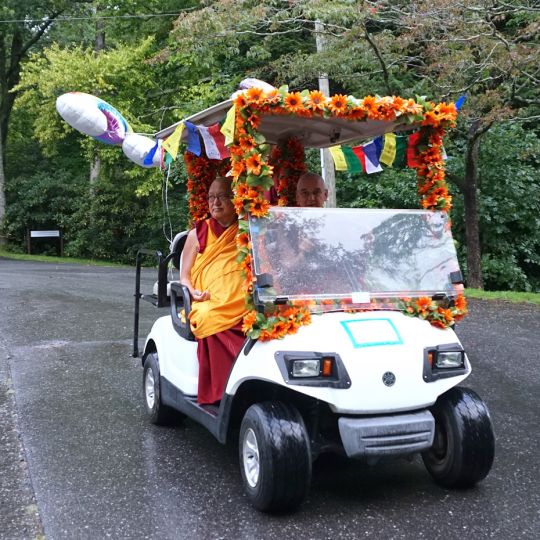
Ven. Roger Kunsang driving Rinpoche to the teaching hall in one of the “bodhichitta buses” at Light of the Path, Black Mountain, North Carolina, US, August 2017. Photo by Ven. Lobsang Sherab.
The month-long 2017 Light of the Path retreat in North Carolina, US, concluded on September 17. Recorded video and audio of the teachings in English as well as in translation to Chinese, French, Italian, and Spanish are all available from FPMT.org, where you can also find the unedited English transcript of Rinpoche’s teachings.
Photos from Rinpoche’s visit to North Carolina have been posted in a new photo album.
From Light of the Path, Rinpoche traveled to Vienna, Austria, where he will be teaching September 29-October 1 at Panchen Losang Chogyen Gelugzentrum.
Then, on October 4, Rinpoche begins the month-long 100 Million Mani Retreat at Istituto Lama Tzong Khapa in Italy.
Details on live streaming these events will be announced soon.
Links to resources in this post
Light of the Path 2017 video, audio, and transcript:
https://fpmt.org/media/streaming/teachings-of-lama-zopa-rinpoche/light-of-the-path-teachings-2017/
Lama Zopa Rinpoche in North Carolina photo album:
https://photos.app.goo.gl/mv5XcRHpnRbuSgnc7
Information on the 100 Million Mani Retreat at Istituto Lama Tzong Khapa in Italy:
https://www.iltk.org/en/lama-zopa-rinpoche-2017/
Live streaming video of Lama Zopa Rinpoche teachings:
https://fpmt.org/media/streaming/lama-zopa-rinpoche-live/
Lama Zopa Rinpoche is the spiritual director of the Foundation for the Preservation of Mahayana Tradition (FPMT), a Tibetan Buddhist organization dedicated to the transmission of the Mahayana Buddhist tradition and values worldwide through teaching, meditation and community service.
- Tagged: lama zopa rinpoche, light of the path 2017, vienna
20
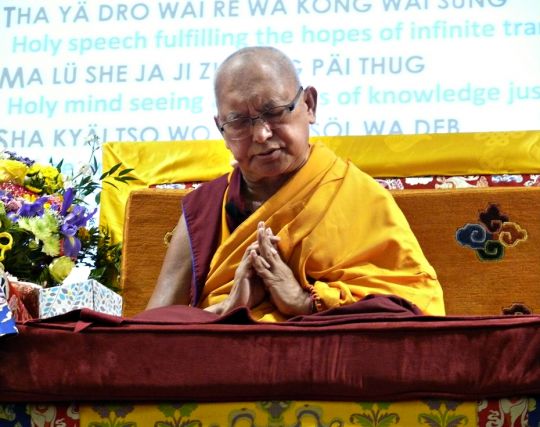
Lama Zopa Rinpoche at Light of the Path, Black Mountain, North Carolina, US, September 2017. Photo by Kalleen Mortensen.
During a session on September 4 at the Light on the Path retreat, Lama Zopa Rinpoche taught on several topics, including continuing a translation of Nagarjuna’s Praise to Satisfy Sentient Beings. From that, Rinpoche spoke to participants about the importance of working at Dharma centers. What follows is an edited version of Rinpoche’s advice on serving sentient being through working for an FPMT center.
You can see that working for the FPMT organization, working for the Dharma center wherever you are, is not just physical work—making a road or building a house or something. (Although even that can be for sentient beings!) Do you understand how bringing the wisdom light of Dharma to the minds of sentient beings—which are like a dark room where they have suffered continuously without end since beginningless rebirths—is so important? How bringing the light of Dharma to the darkness of their hearts and minds is so important?
In the center, whatever you are doing—whether you are the director, the assistant director, the bookkeeper, the cook, the cleaner—is for sentient beings. You are working for sentient beings. You have to keep your mind as Buddha explained and as Nagarjuna explained in Praise to Satisfying Sentient Beings. What you are doing and what has been explained is the same, not opposite.
So, think in your heart about sentient beings. Then, work and benefit sentient beings through whatever work you do. That is what is most pleasing to Buddha’s holy mind. That is what is most pleasing to numberless buddhas and bodhisattvas. It is most pleasing to the guru—His Holiness the Dalai Lama, Lama Yeshe, and so forth. Do you understand? Working for sentient beings is most pleasing to them. Do you see now what is being talked about here in Praise to Satisfying Sentient Beings?
You have to realize that you are not wasting your time, your life. If you go to the beach, you lay your naked body down and spend hours and hours—all day long—there. Then you get into the water, like the sharks. Before, many of those sharks were naked people on the beach. The sharks have been naked people on the beach numberless times. (As I told you, the fish and fishermen trade places, the animals and butchers trade places.) Each person has his own trip of what “pleasure” means. There are all kinds in the world. So now think: “Do I prefer that, or, helping the FPMT Dharma organization and the FPMT centers?”
In an FPMT center, there is a resident teacher who teaches lamrim philosophy—either simply or complexly—whatever is needed. If he or she doesn’t speak English, then a translator is provided. And nowadays, even the Western students themselves are able to explain and teach. Before, we needed geshes. Now that the Masters Program and Basic Program are running, lay students teach philosophy, even in centers where there are geshes. FPMT developed this. But to have all that, you need facilities—you need many things. So, you provide those things. And you need all that to help sentient beings, to help yourself and to help others.
Between the body and mind, everyone at the Dharma center is there to help the minds of sentient beings. By running the center with the mind of Dharma—correctly following the virtuous friend, renunciation, bodhichitta, and emptiness (without even talking about tantra)—whatever you are doing there, whatever the center does becomes virtue. Everything becomes the cause of achieving nirvana and nothing becomes the cause of achieving samsara. Everything becomes the cause of enlightenment. Everything becomes the cause of enlightenment if the main effort of everyone working in the center is put into cultivating a bodhichitta motivation. This is the best way to benefit sentient beings.
To bring about world peace, the basic thing needed is for people to learn about and develop compassion. Basic Dharma is compassion. If you create negative karma, if you harm other sentient beings, the result is that you will be harmed for hundreds, thousands, and millions of lifetimes. If you benefit others, then you will have success in your life for hundreds, thousands, millions, and billions of lifetimes—it goes on and on. All happiness comes.
At the Dharma center, you teach basic Buddhism: compassion and wisdom. Therefore, students come to know about karma. They abandon negative karma, which causes suffering, and create good karma, which brings happiness. Dharma centers bring so much peace and compassion to the world. They teach compassion and wisdom. They teach what is right and what is wrong. From that which is right, comes all happiness up to enlightenment. From that which is wrong, comes all the sufferings. That is why students need to learn Dharma. And not only lamrim, but philosophy too.
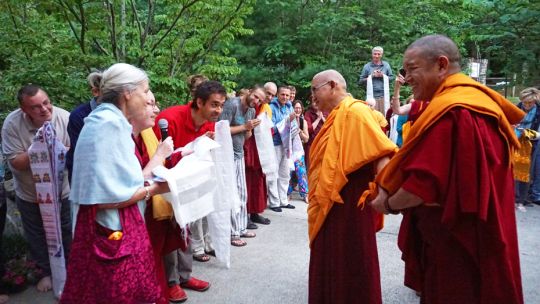
At Light of the Path, Ven. Chantal Carrerot, Paula Chichester, and Alexis Benelhadj request Rinpoche to give a Vajrayogini retreat at Institut Vajra Yogini in France, September 2017. Photo by Ven. Lobsang Sherab.
So, the centers are sooooo important. The centers are where sentient beings are allowed to learn Dharma and to meditate. Centers are where there are facilities, teachers, translators. They are so, so, so important for sentient beings. You cannot imagine how important they are, how needed they are. In the centers, everything that is done is for sentient beings. Can you imagine? It’s so important, so important, so important.
By remembering that you are involved in this, you should always be happy. As I often say, I thought people who had won at soccer were angry—because they weren’t smiling; their veins pop out they raise up their arms! Later, I realized it meant that they were unbelievably happy. But that’s nothing. That happiness is nothing because it doesn’t protect them from the lower realms.
For us, we have to be joyous nonstop like a soccer player who has won a match. We have to express our joy—with our arms raised—day and night, all the time, every second. People might think you are crazy because you aren’t playing soccer! If you are defeating other people in a match, it’s OK for you to raise your arms, but because you aren’t defeating other people in a match, they think you are crazy and should go to an institution. In reality, you are making so much merit, so much happiness in every second—it’s unbelievable, unbelievable. You are following the guru’s advice and fulfilling the guru’s holy wishes, which collects the highest merit. Whatever you are doing while working for the center collects the highest merit and is the greatest purification of negative karma collected since beginning rebirths. You have to recognize that.
Excerpted from Light of the Path 2017, Blue Ridge Mountains, North Carolina, United States, September 4, 2017. Edited by Mandala for FPMT.org.
Lama Zopa Rinpoche is the spiritual director of the Foundation for the Preservation of Mahayana Tradition (FPMT), a Tibetan Buddhist organization dedicated to the transmission of the Mahayana Buddhist tradition and values worldwide through teaching, meditation, and community service.
Find recordings of Lama Zopa Rinpoche teaching around the world, including at the Light of the Path retreat at https://fpmt.org/RinpocheNow/.
Join Lama Zopa Rinpoche’s 100 Million Mani Retreat at Istituto Lama Tzong Khapa in Italy: October 4-November 5, 2017. Find out more at:
https://www.iltk.org/en/lama-zopa-rinpoche-2017/
18
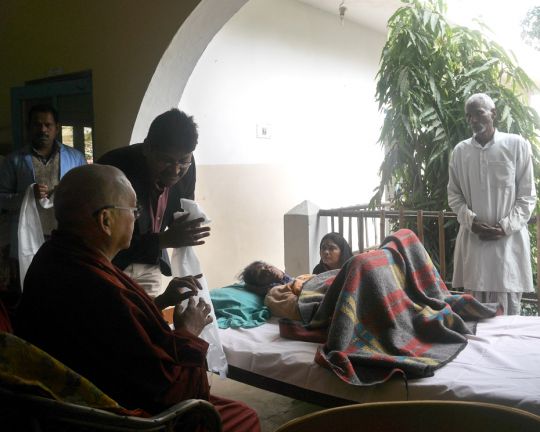
Lama Zopa Rinpoche blessing a very sick patient of Shakyamuni Health Clinic; Rinpoche did short Medicine Buddha practice for her and all the patients there, Bodhgaya, India, April 2017. Photo by Ven. Holly Ansett.
Lama Zopa Rinpoche sent the following advice to a person who fell down and was injured, and is still very sick as well as worried because he hasn’t gotten better.
Think that I am the most fortunate one, that I have this sickness, I am the most fortunate one. Why? Because by having this sickness now I can practice pure Dharma. I have been given the opportunity to practice pure Dharma. So I can experience all sentient beings’ pain, disease, spirit harm, negative karma, and obscurations, and they can all achieve the dharmakaya.
Also you can meditate that you receive all sentient beings’ pain, disease, negative karma, and obscurations. Think that you have received these in your heart in the form of darkness, like smoke, like black fog, and they destroy the self-cherishing thought, where all the sufferings come from. They are brought into the heart and received there, like throwing an atomic bomb on the enemy, so self-cherishing thoughts are totally smashed. So here you give this to the self-cherishing thought that has caused you beginningless oceans of samsara in the six realms up to the present, as well as the present and endless future oceans of suffering—not only your suffering but has also given suffering to numberless sentient beings from beginningless lives up to now—and as long as you don’t generate bodhichitta, it will bring endless suffering to numberless sentient beings again. So destroy the one enemy, this self-cherishing thought, so it is totally destroyed. And think that all sentient beings receive dharmakaya.
You can do tonglen, if you can, taking on others’ suffering and with compassion giving your body, possessions, and merits to other sentient beings, with loving kindness, so they all receive enlightenment, achieve rupakaya.
[If you can listen to the teachings that Rinpoche recently gave at the Light of the Path retreat in North Carolina, it is all online. If you can watch that or listen to that, it would be very good].
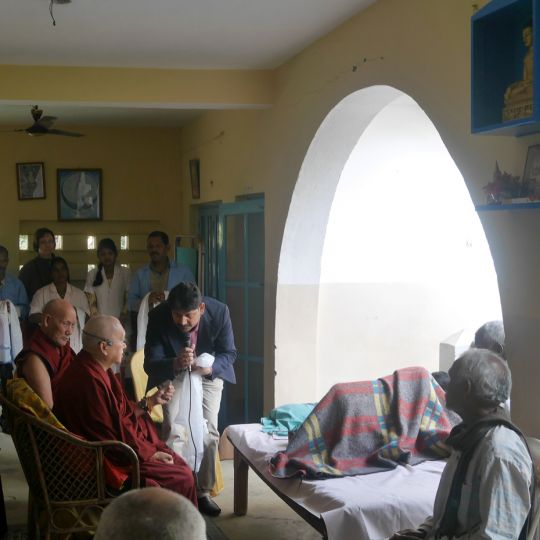
Lama Zopa Rinpoche at Shakyamuni Health Clinic, Bodhgaya, India, April 2017. Photo by Ven. Holly Ansett.
Then much of your day you can recite this, like a mantra but instead of a mantra. If you can, do at least a few malas a day of this:
“By my having to experience this sickness, may all sentient beings be free immediately from all the diseases, spirit harm, negative karma, and defilements.”
So pray like this and recite this each day and do a few malas. This prayer is from the great yogi Choje Götsangpa.
So you can see this sickness is helping you. That is why I said how fortunate you are. You can collect more than skies of merit and purify negative karma and defilements collected from beginningless rebirth. This brings you to enlightenment quickly. This is why I said in the beginning how fortunate you are to think in this way.
It is very, very, very good, in reality it is like this. This is a gain, not a loss for you, the highest gain, so please do this.
With much love and prayers,
Lama Zopa Rinpoche
Transcribed by Ven. Holly Ansett, Buddha Amitabha Pure Land, Washington, USA, November 2016. Lightly edited by Mandala.
Lama Zopa Rinpoche is the spiritual director of the Foundation for the Preservation of Mahayana Tradition (FPMT), a Tibetan Buddhist organization dedicated to the transmission of the Mahayana Buddhist tradition and values worldwide through teaching, meditation, and community service.
Find recordings of Lama Zopa Rinpoche teaching around the world, including at the Light of the Path retreat at https://fpmt.org/RinpocheNow/.
Join Lama Zopa Rinpoche’s 100 Million Mani Retreat at Istituto Lama Tzong Khapa in Italy: October 4-November 5, 2017. Find out more at:
https://www.iltk.org/en/lama-zopa-rinpoche-2017/
- Tagged: advice from lama zopa rinpoche, sickness
- 0
13
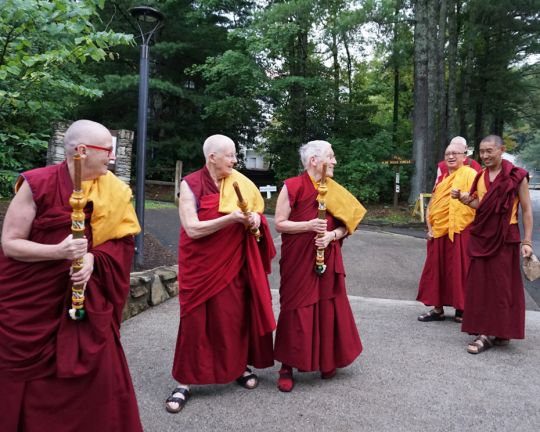
Sangha from Australia and New Zealand leading Lama Zopa Rinpoche to the teaching hall at the Light of the Path retreat, North Carolina, US, September 2017. Photo by Ven. Lobsang Sherab.
In the video below, Lama Zopa Rinpoche talks about the impact of keeping vows on the power of prayer. He says that the more vows we have, and keep purely, the more power our prayers will have. Therefore, when monastics pray for others, their prayers “have so much power”!
Whatever monks and nuns pray for will have more success because of their vows, says Rinpoche in the video, which was recorded at the Light of the Path 2016 retreat. Making offerings to monks and nuns is also very meritorious because their many vows help make them more pure; such offerings have enormous future karmic benefits for whoever makes them.
Watch Rinpoche talk on YouTube about the relationship between vows, merit, and effective prayers:
https://www.youtube.com/watch?v=XULE495JKZ0&feature=youtu.be
Watch more video from the 2016 Light of the Path Retreat and find links to translations, MP3s, and the complete transcript:
https://fpmt.org/media/streaming/teachings-of-lama-zopa-rinpoche/light-of-the-path-teachings-2016/
Watch Lama Zopa Rinpoche teach LIVE at the Light of the Path retreat August 20-September 17, 2017:
https://fpmt.org/media/streaming/lama-zopa-rinpoche-live/
It’s not too late to join Lama Zopa Rinpoche’s 100 Million Mani Retreat at Istituto Lama Tzong Khapa in Italy: October 4-November 5, 2017. Find out more at:
https://www.iltk.org/en/lama-zopa-rinpoche-2017/
Lama Zopa Rinpoche is the spiritual director of the Foundation for the Preservation of Mahayana Tradition (FPMT), a Tibetan Buddhist organization dedicated to the transmission of the Mahayana Buddhist tradition and values worldwide through teaching, meditation, and community service.
- Tagged: essential extract, lama zopa rinpoche, light of the path, light of the path 2016, monks, nuns, prayer, video
11
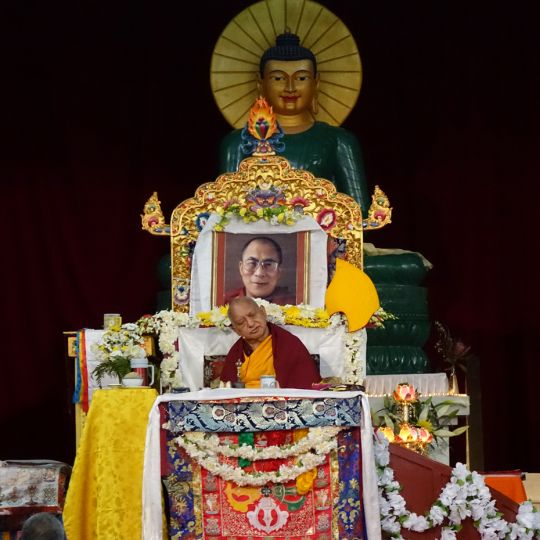
Lama Zopa Rinpoche teaching at Australia 2014 retreat at the Great Stupa of Universal Compassion, Bendigo, Australia, October 2014. Photo by Ven. Roger Kunsang.
Registration is now open for Lama Zopa Rinpoche’s Bodhicaryavatara and Rinjung Gyatsa retreat at the Great Stupa of Universal Compassion in Bendigo, Australia, March 30-May 12, 2018! This six-week retreat is the third in series of retreats given in Australia by Rinpoche.
“This retreat came about because the late Khunu Lama Rinpoche requested Lama Zopa Rinpoche to translate Shantideva’s Bodhicaryavatara (A Guide to the Bodhisattva’s Way of Life),” explained Ven. Roger Kunsang, Rinpoche’s assistant and CEO of FPMT. “Khunu Lama Rinpoche made this request after he gave Lama Zopa Rinpoche the commentary on the Bodhicaryavatara at Lama Zopa Rinpoche’s request. So Lama Zopa Rinpoche is teaching the Bodhicaryavatara at the same time as translating it. (A small team led by Ven. Ailsa Cameron is carefully noting Rinpoche’s translation as he teaches.)
“Then Lama Zopa Rinpoche was requested by Ven. Gyatso (director of Thubten Shedrup Ling Monastery in Bendigo) to give the Rinjung Gyatsa set of initiations, which is quite rare. Rinpoche commented that it is common in the Tibetan Buddhist tradition to organize initiations into ‘sets.’ Also that different deities have different purposes and benefits, and that once you receive the permission to practice that deity, you have more potential to help others and are also helping to preserve Buddhism.
“Lama Zopa Rinpoche has combined both into one retreat. The first installment of this retreat was in April 2011 and the second installment took place in September-October 2014.”
You can register for the Bodhicaryavatara and Rinjung Gyatsa retreat 2018 at the Great Stupa and find additional information on the retreat website:
http://lamazoparetreat2018.org.au/
An early-bird discount is offered on registration before October 31, 2017.
Read about the April 2011 retreat in the Mandala story “The Retreat of a Life Time.” The September-October 2014 retreat was covered in many FPMT news blog posts, which include links to video from Rinpoche’s teachings there. You can also access video recordings of Rinpoche’s teachings from the Australia 2014 retreat on FPMT’s Rinpoche Available Now page (fpmt.org/rinpochenow/).
Watch Lama Zopa Rinpoche teach LIVE at the Light of the Path retreat August 20-September 17, 2017:
https://fpmt.org/media/streaming/lama-zopa-rinpoche-live/
It’s not too late to join Lama Zopa Rinpoche’s 100 Million Mani Retreat at Istituto Lama Tzong Khapa in Italy: October 4-November 5, 2017. Find out more at:
https://www.iltk.org/en/lama-zopa-rinpoche-2017/
Lama Zopa Rinpoche is the spiritual director of the Foundation for the Preservation of Mahayana Tradition (FPMT), a Tibetan Buddhist organization dedicated to the transmission of the Mahayana Buddhist tradition and values worldwide through teaching, meditation, and community service.
- Tagged: australia retreat 2018, lama zopa rinpoche
7
The retreatants at the Light of the Path 2017 retreat spent a practice session reciting Kshitigarbha mantras on Tuesday, September 5. Participants did 2,000 recitations of the long Kshitigarbha mantra and 10,000 recitations of the middle-length Kshitigarbha mantra at Lama Zopa Rinpoche’s request. On Wednesday, September 6, they did 13,000 recitations of the middle-length mantra. The practice was dedicated to pacify the harm caused by natural disasters, especially from upcoming hurricanes.
Students concerned about Hurricane Irma, which as of Thursday afternoon is a category 5 hurricane tearing through the Caribbean towards Florida, can recite the middle-length Kshitigarbha mantra:
OM SUMBHA NI SUMBHA / HARA TSARA / MAHAA PAASHA MARAUTAA / AMOGHA VAJRASATTVA SWAAHAA
In the past, Rinpoche has also advised to do Kshitigarbha practice and protector prayers to pacify harm from hurricanes. You can find more advice from Rinpoche on natural disasters on FPMT’s Advice from Lama Zopa Rinpoche page.
Watch Light of the Path Recite Kshitigarbha Mantra:
https://youtu.be/WM3TQtoE850?t=1922
Links to resources mentioned in the post:
Middle-length Kshitigarbha mantra:
https://shop.fpmt.org/Ksitigarbha-Mantras-PDF_p_3611.html
Kshitigarbha Practice complied by Lama Zopa Rinpoche:
https://shop.fpmt.org/Kshitigarbha-Practice-eBook-PDF_p_2522.html
Protector prayers:
https://shop.fpmt.org/Protector-Prayers-PDF_p_1381.html
Advice from Lama Zopa Rinpoche on FPMT.org:
https://fpmt.org/teachers/zopa/advice/
Watch Lama Zopa Rinpoche teach LIVE at the Light of the Path 2017 retreat August 20-September 17:
https://fpmt.org/media/streaming/lama-zopa-rinpoche-live/
Lama Zopa Rinpoche is the spiritual director of the Foundation for the Preservation of Mahayana Tradition (FPMT), a Tibetan Buddhist organization dedicated to the transmission of the Mahayana Buddhist tradition and values worldwide through teaching, meditation, and community service.
6
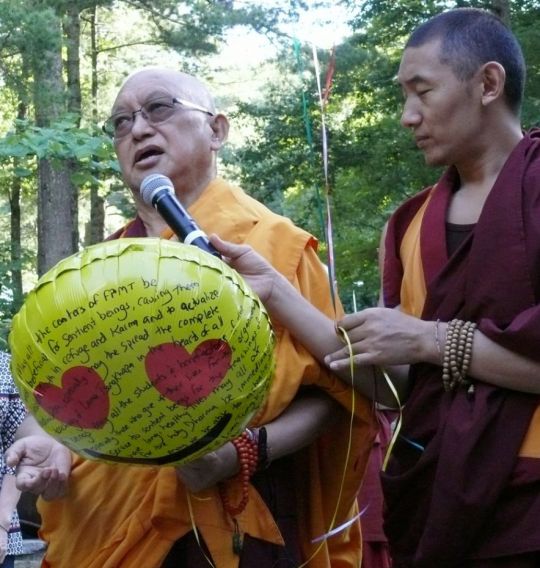
Lama Zopa Rinpoche before mantra balloon release at Light of the Path retreat, Black Mountain, North Carolina, US, August 2017. Photos by Kalleen Mortensen.
Lama Zopa Rinpoche released balloons with mantras he had written on them to bless all the sentient beings who pass underneath them. During a break between sessions at the Light of the Path in North Carolina, Rinpoche had the retreatants gather and explained the meanings of some of the mantras written on the balloons before they were released.
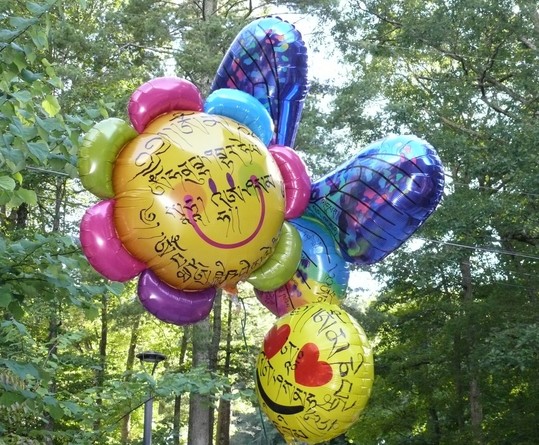
Mantra balloons before being released to spread blessing to all sentient beings who pass underneath them
The mantras included OM MANI PADME HUM (the mantra of the Buddha of Compassion), the “Just by Seeing” mantra, “Six Syllables of Clairvoyance” mantra, and the “Lotus Pinnacle” mantra. The balloons also had extensive dedications written on them, which were read aloud. Rinpoche’s explanation, the dedications, and the balloon release were captured in a five-minute video.
WATCH Rinpoche Explain the Benefits of Mantra Balloons on YouTube:
https://youtu.be/aL_UfDb3B6Y
Find more resources on mantras on FPMT Education Services’ mantra page:
https://fpmt.org/education/prayers-and-practice-materials/mantras/
Watch Lama Zopa Rinpoche teach LIVE at the Light of the Path 2017 retreat August 20-September 17:
https://fpmt.org/media/streaming/lama-zopa-rinpoche-live/
Lama Zopa Rinpoche is the spiritual director of the Foundation for the Preservation of Mahayana Tradition (FPMT), a Tibetan Buddhist organization dedicated to the transmission of the Mahayana Buddhist tradition and values worldwide through teaching, meditation, and community service.
- Home
- News/Media
- Study & Practice
- About FPMT Education Services
- Latest News
- Programs
- New to Buddhism?
- Buddhist Mind Science: Activating Your Potential
- Heart Advice for Death and Dying
- Discovering Buddhism
- Living in the Path
- Exploring Buddhism
- FPMT Basic Program
- FPMT Masters Program
- FPMT In-Depth Meditation Training
- Maitripa College
- Lotsawa Rinchen Zangpo Translator Program
- Universal Education for Compassion & Wisdom
- Online Learning Center
- Prayers & Practice Materials
- Overview of Prayers & Practices
- Full Catalogue of Prayers & Practice Materials
- Explore Popular Topics
- Benefiting Animals
- Chenrezig Resources
- Death & Dying Resources
- Lama Chopa (Guru Puja)
- Lama Zopa Rinpoche: Compendium of Precious Instructions
- Lama Zopa Rinpoche: Life Practice Advice
- Lama Zopa Rinpoche Practice Series
- Lamrim Resources
- Mantras
- Prayer Book Updates
- Purification Practices
- Sutras
- Thought Transformation (Lojong)
- Audio Materials
- Dharma Dates – Tibetan Calendar
- Translation Services
- Publishing Services
- Teachings and Advice
- Find Teachings and Advice
- Lama Zopa Rinpoche Advice Page
- Lama Zopa Rinpoche: Compendium of Precious Instructions
- Lama Zopa Rinpoche Video Teachings
- ༧སྐྱབས་རྗེ་བཟོད་པ་རིན་པོ་ཆེ་མཆོག་ནས་སྩལ་བའི་བཀའ་སློབ་བརྙན་འཕྲིན།
- Podcasts
- Lama Yeshe Wisdom Archive
- Buddhism FAQ
- Dharma for Young People
- Resources on Holy Objects
- Ways to Offer Support
- Centers
- Affiliates Area
- Teachers
- Projects
- Charitable Projects
- Make a Donation
- Applying for Grants
- News about Projects
- Other Projects within FPMT
- Support International Office
- Projects Photo Galleries
- Give Where Most Needed
- FPMT
- Shop
Translate*
*powered by Google TranslateTranslation of pages on fpmt.org is performed by Google Translate, a third party service which FPMT has no control over. The service provides automated computer translations that are only an approximation of the websites' original content. The translations should not be considered exact and only used as a rough guide.Bad Education is like a prison. We must learn to open the prison, and psychologically liberate human beings.
